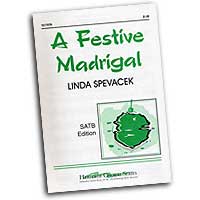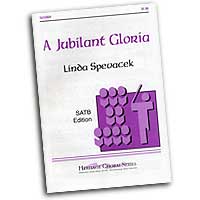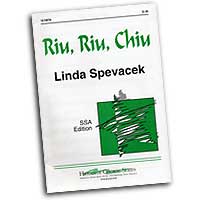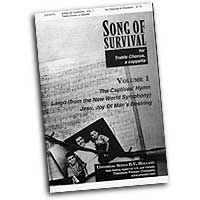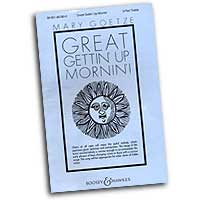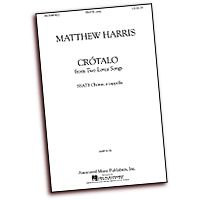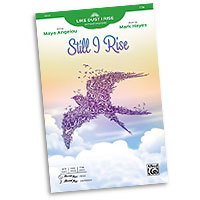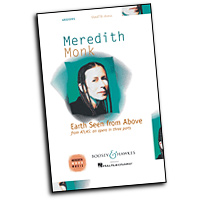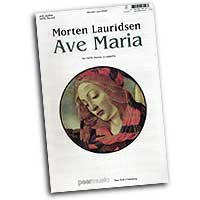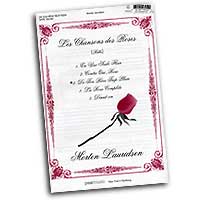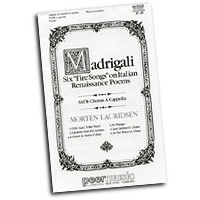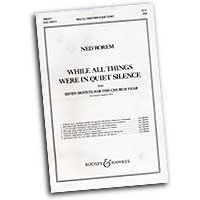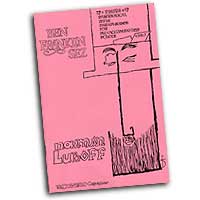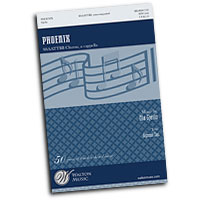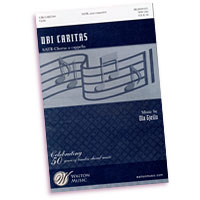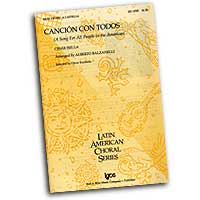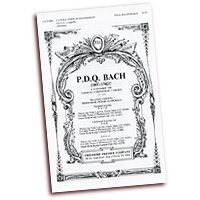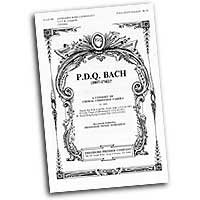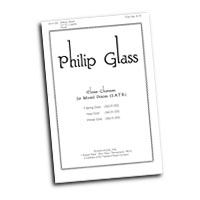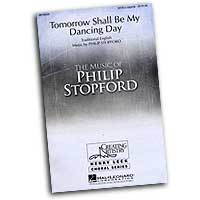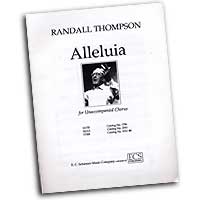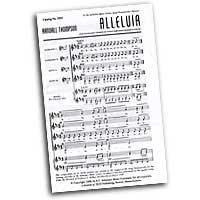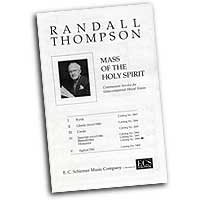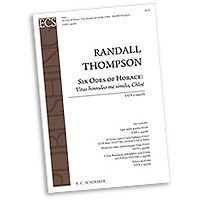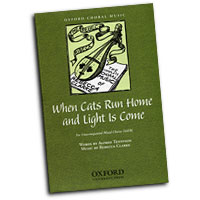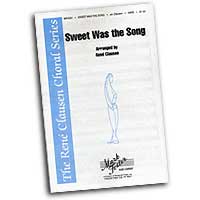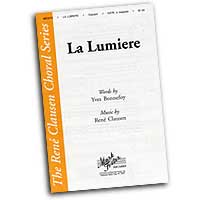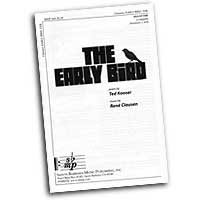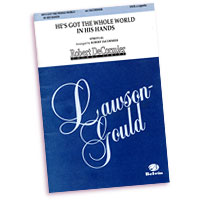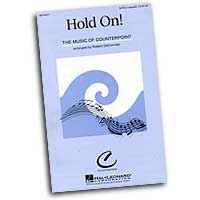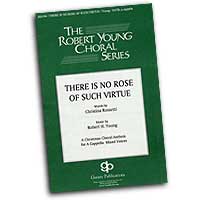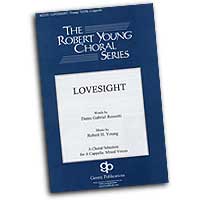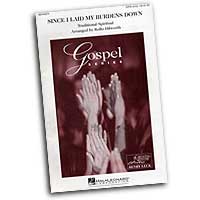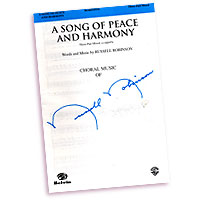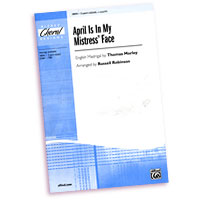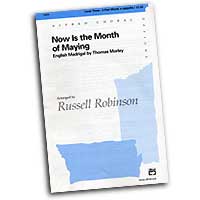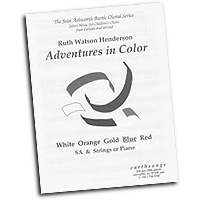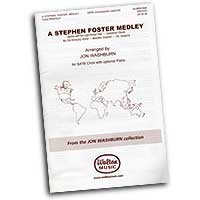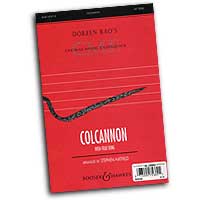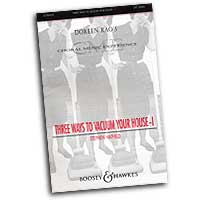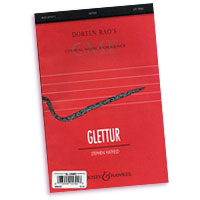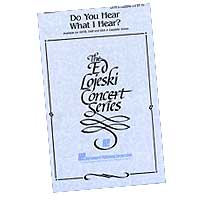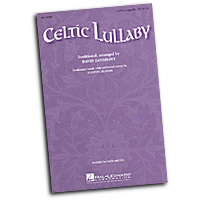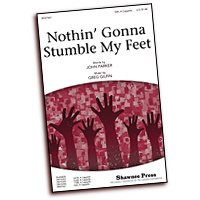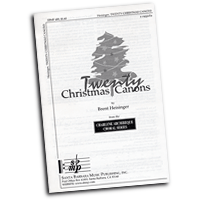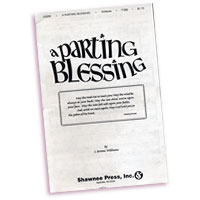In Celebration of the Human Voice - The Essential Musical Instrument
Home | Doo Wop | Barbershop | World | Contemporary | Christian | Vocal Jazz | Choral | Christmas | Instructional | Arrangements
Classical | Opera | Musicals | Personality | Young Singers | Disney | Videos | Songs | The Artists

A Cappella Compilations CDs & DVDs
Want to listen to a bunch of different groups or discover the wide variety of music created by the human voice? Then these a cappella compilation CDs and DVDs are perfect for those wishing to sample as many groups as possible.
Displaying 551-600 of 843 items.
Review: 'Christmas Madrigal Roundezvous' is a sparkling, festive, and extremely clever original madrigal, sung in a round, with a contrasting, lilting middle section. The uplifting lyrics of 'A Festive Madrigal' begin that bright, jovial original madrigal, which 'sings in' the holiday season. A marvelous, accessible choice which also works well for smaller ensembles. The refreshing, new, secular Christmas madrigal 'Come, Sing! Come, Dance!' will definitely capture the spirit of the season. Designed for small or large groups, this a cappella gem is easy and accessible, yet sophisticated and challenging. Delightfully creative and absolutely charming!
Songlist: Christmas Madrigal Roundezvous, Come Sing, Come Dance
Voicing: a-cappella/arrangements/christmas/choral/
Review: 'Alleluia' was commissioned for performance at the 1999 National ACDA Convention. A hushed chant is woven into dramatic musical lines and lush harmonies that later fade to an ending of quiet splendor. With the grandeur of a more challenging work, this piece sings easily, enabling accessibility to a variety of performing groups. Spevacek has 'Lo, How a Rose E'er Blooming' in a sensitive, transparent fashion with lush harmonies and textual contrasts. 'A Jubilant Gloria' is an exceptional work that offers driving rhythmic excitement from its fanfare-like opening to its exhilarating conclusion. This sophisticated piece sings easily and sounds gloriously full.
Songlist: Alleluia, A Jubilant Gloria, Lo, How a Rose E'er Blooming
Voicing: a-cappella/arrangements/sacred/
Review: The vibrant, upbeat original, 'A Glad Noel' is a marvelous opener or change-of-pace selection. Its fanfare-like style and bright mood will inspire the joyous spirit of the season. Creative and charming, it is easy and accessible, yet sounds sophisticated, make it an ideal choice. 'A Jubilant Gloria' is an exceptional work that offers driving rhythmic excitement from its fanfare-like opening to its exhilarating conclusion. This sophisticated piece sings easily and sounds gloriously full. The new voicings of this best-selling arrangement of the Spanish Carol, 'Riu, Riu, Chiu,' include text options for English or Spanish. Tambourine and hand claps lend a festive, colorful flair. Whether performed with or without piano accompaniment, the limited ranges, repetitious form, and opportunities for solos yield built-in success for holiday programs.
Songlist: A Glad Noel, A Jubilant Gloria, Riu, Riu, Chiu
Voicing: a-cappella/arrangements/christmas/ssaa/
Review: These pieces of music came into being in a prison camp on Sumatra. The initial idea was Norah Chambers, and Margaret Dryburgh and her worked on the various pieces. Some they did together and others individually, depending on how well we could remember the original pieces of music. The idea was to bring singers together - Dutch, British, Australian - about thirty in all, to make music to uplift us and perhaps to bring some beauty and sanity. The music was written on odd bits of paper, mostly in pencil, and written as small as possible to save paper. It was difficult at first to sing without words, what sound to make, the tempo and the color. The One sound not used was "AH." It was too throaty. We found the best sounds were "Ne, Le." When notes had to be sung together, as in "Morning Sun," the sixteenth notes were not broken, but sung legato. The sounds used were "Le," with the accent on the first note of the sixteenth notes, such as humming was used when there was a solo singer as undercurrent to the melody.
Songlist: Song of Survival Vol. 1, Song of Survival Vol. 2, Song of Survival Vol. 3, Song of Survival Vol. 4, Song of Survival Vol. 5, Song of Survival Vol. 6
Voicing: sheet-music/female-voices/
Review: "I'm Goin' Home" - Arranged with a simple and accessible vocal accompaniment that enhances the intense hope expressed in the text and melody. Stepwise contrapuntal melodic phrases and repeated harmonic patterns provide a carpet of vocal sounds for the inspiring melody. Builds to an effective climax in the coda with an unexpected harmonic turn. "Great Getting' Up Morning" - Choirs of all ages will enjoy this joyful melody, which expresses great optimism and anticpiation. The range of the lower countermelody is narrow enough to accommodate the early phases of boys changing voices or those with a narrow range. This song will be appropiate for older choirs of treble voices. "Give Way Jordan" - An imitative part and a lively counter-melody accompany the simple refrain of this spiritual, contrasted by the verse in which singing in parallel thirds is practiced.
Songlist: Give Way, Jordan, Sing Alleluia, Allelu, Great Gettin' Up Mornin'!, I'm Goin' Home on a Cloud
Voicing: a-cappella/arrangements/spirituals/mixed/
Review: Two Lorca Songs are based on the first major work "Poema del Cante Jondo" (Poem of the Deep Song) of the famous Spanish poet Garcia Lorca. Las Seis Cuerdas was inspired by the poem's haunting melancholy. Sopranos and altos sing falling, weeping lines while underneath basses and tenors have wide guitar-like intervals. Crotalo, written for choral competition, is meant to display choral virtuosity. It is set as a flamenco: the percussive c's and t's from the repeated word "crotalo" make a rhythmical clicking like that of castanets.
Songlist: Crotalo, Las Seis Cuerdas
Voicing: choral/latin-american/
Review: "Like Dust I Rise" is a choral song cycle from the poems of Maya Angelou which can be performed separately or as a set. "Equality" - This contemporary gospel-style rouser denounces oppression and serves as a choral anthem for equal rights. A confident solo voice helps deliver a determined message in the unwavering words of Maya Angelou. "On the Pulse of Morning" - Angelou's audio recording of "On the Pulse of Morning" won a Grammy Award for "Best Spoken Word" in 1994. Mark Hayes opens with a resounding "See Me Rise" choral fanfare before presenting the hope-filled latter half of the poem with rhythmic exuberance. "Caged Bird" - A folk-like setting of Maya Angelou's empowering poem, which compares a bird's longing to be liberated with that of all people. Hayes chooses a minor key with plenty of harmonic tension and a walking tempo that suggests the footsteps of those who have come before. The final Picardy third is the ultimate symbol of freedom. "Still I Rise" - Maya Angelou's most popular poem about triumph over adversity comes brilliantly to life in this vivid setting by Mark Hayes. The bright shuffle tempo and bluesy piano riffs perfectly embody Angelou's strength, courage, and determination to rise above. One of the most uplifting choral selections of our time!
Songlist: Equality, On the Pulse of Morning, Caged Bird, Still I Rise
Voicing: sheet-music/civil-rights/
Review: "Like Dust I Rise" is a choral song cycle from the poems of Maya Angelou which can be performed separately or as a set. "Equality" - This contemporary gospel-style rouser denounces oppression and serves as a choral anthem for equal rights. A confident solo voice helps deliver a determined message in the unwavering words of Maya Angelou. "On the Pulse of Morning" - Angelou's audio recording of "On the Pulse of Morning" won a Grammy Award for "Best Spoken Word" in 1994. Mark Hayes opens with a resounding "See Me Rise" choral fanfare before presenting the hope-filled latter half of the poem with rhythmic exuberance. "Caged Bird" - A folk-like setting of Maya Angelou's empowering poem, which compares a bird's longing to be liberated with that of all people. Hayes chooses a minor key with plenty of harmonic tension and a walking tempo that suggests the footsteps of those who have come before. The final Picardy third is the ultimate symbol of freedom. "Still I Rise" - Maya Angelou's most popular poem about triumph over adversity comes brilliantly to life in this vivid setting by Mark Hayes. The bright shuffle tempo and bluesy piano riffs perfectly embody Angelou's strength, courage, and determination to rise above. One of the most uplifting choral selections of our time!
Songlist: Equality, On the Pulse of Morning, Caged Bird, Still I Rise
Voicing: sheet-music/civil-rights/
Review: Meredith Monk is an acclaimed composer, singer, director/choreographer and creator of new opera, music theater works, films and installations. A pioneer in what is now called "extended vocal technique" and "interdisciplinary performance," Monk creates works that thrive at the intersection of music and movement, image and object, light and sound in an effort to discover and weave together new modes of perception. Here are a cappella arrangements for mixed voices of some of her works that will challenge and reward.
Songlist: Astronaut Anthem, Panda Chant II, Earth As Seen From Above
Voicing: a-cappella/arrangements/wordless/
Review: This collection of Lauridensen's aural artisanship contains hits such as "O Nata Lux," a serene a cappella motet celebrating the Redeemer, "Ubi Caritas Et Amor," a motet composed "in celebration and gratitude for the glorious and enduring service to God," as well as a setting of "Ave Maria" specially composed as a seventieth birthday gift to Maestro Salamunovich.
Songlist: O Nata Lux, Ave Maria, Ubi Caritas et Amor, Soneto de la Noche
Voicing: a-cappella/arrangements/choral-modern/
Review: "Les Chansons des Roses" is a collection of compositions based on the poetry of Rainer Maria Rilke. Says Lauridsend of his selection: "(Rilke') poems on roses struck me as expecially charming, filled with gorgeous lyricism, deftly crafted and elegant in their imagery. There exquisite poems are primarily light, joyous and playful, and the musical settings are designed to enhance these characteristics and capture their delicate beauty and sensuousness."
Songlist: Dirait-on, Contre Qui Rose, De Ton Reve Trop Plein, La Rose Complete, En Une Seule Fleur
Voicing: a-cappella/arrangements/choral-modern/
Review: THhe Six Fire Songs have been featured at major choral festivals around the world. Hailed by the Los Angeles Times as "stunningly crafted", the Madrigalli are unified by romantic references to fire in each of the poems. Characteristic Italian Rennaissance "madrigalisms" such as word painting, modality, bold harmonic shifts, intricate counterpoint and augenmusik occur throughout the cycle.
Songlist: Amor, Io Sento L'Alma, Ov'e Lass, Il Bel Viso?, Quando son piu Lontan, Io Pango, Se Per Favervi, oime, Luci serene e Chiare
Voicing: a-cappella/arrangements/choral-modern/
Review: Ned Rorem's 'Seven Motets for the Church Year' was commissioned by All Saints Episcopal Church in Ft. Laurderdale, FL, on the occasion of its 75th Anniversary. All seven movements are beautiful 4 part settings of Antiphons, to be used throughout the year.
Songlist: While All Things Were In Quiet Silence, Before the Morning Star Begotten, Lay Up For Yourselves, Praise Him Who Was Crucified, God Is Gone Up, Today the Holy Spirit Appeared, Rejoice We All in the Lord
Voicing: a-cappella/arrangements/motet/
Review: Explore the American heritage of Shaker hymnody with these three settings of lesser-known, very appealing Shaker spirituals. Each brief setting grows from its underlying melody to make an exceptionally unified arrangement. With a different technique as the focus for each arrangement, these minute-long pieces make fine vocalises for your choir. "Oh the beautiful treasure," with its square rhythms, horn calls, and harmonic texture opening out and closing, is excellent for teaching chord tuning. "We will walk with Mother and mourn," with its smooth, stepwise, rising and falling melody, is a fine exercise for legato singing. "Hop up and jump up," with its crisp rhythms and phrase fragments tossed from part to part, calls for rhythmic clarity and clean entrances and cutoffs.
Songlist: Oh, The Beautiful Treasure, We Will Walk with Mother and Mourn, Hop Up and Jump Up
Voicing: a-cappella/arrangements/spirituals/female/
Review: The Norman Luboff Choir became one of the leading choral groups in the world, recording a wide variety of music on more than seventy-five LPs and touring yearly from 1963 to 1987. As an educator, Mr. Luboff was in much demand, guest conducting all-state, clinic, and festival choirs of every description in the United States and abroad. Here's a wonderful collection of fun a cappella arrangements from the maestro himself.
Songlist: Baloo Lammy, Ben Franklin Sez, Black Is the Color, Go to Sleepy, Much More Ado About Nothings (Collection), Nobody Knows the Trouble I've Seen
Review: The music of Manhattan-based Norwegian composer Ola Gjeilo (b. 1978) has been performed and recorded in more than 30 countries worldwide in venues such as New York's Carnegie Hall, Los Angeles' Disney Hall, Philadelphia's Kimmel Centeri, Washington DC's Kennedy Center and National Gallery, as well as the Copenhagen and Oslo Opera Houses. His music has been featured on PBS and radio stations across the US. "The Spheres" - This movement is the beginning of a Mass called Sunrise, and, according to its composer, it is to "be performed with the sense of floating in space." A fine challenge for accomplished high school choirs and beyond! The setting uses the Latin Kyrie Eleison text. "Phoenix" - Written for larger, mature choirs, Gjeilo uses the Latin "Agnus Dei" text as support for this symphonic-sounding choral work. With its beautiful color, intonation and phrasing, it is a great choice for advanced high school, college and beyond. "Northern Lights" - Set to the Latin "Pulchra es amica mea" text from Song of Solomon, this easy-to-prepare composition is a great selection for high school, church and community choirs. With music inspired by the aurora borealis atmospheric lights, this song will render a most impressive performance
Songlist: Tota Pulchura Es, Northern Lights, The Spheres, Phoenix
Voicing: a-cappella/arrangements/choral-modern/
Review: "Unicornis CaptiIvatur" is an exciting, adventurous piece sets an unusual Latin text to music that ranges in style from renaissance dance to shimmering chorales to chant, and in texture from unison to an expansive eight parts. Requiring highly developed musicianship, this work is sure to become a memorable concert highlight. "Sanctus" is atmospheric and intense, featuring contrasts of ethereal melody lines supported by stately, rich harmonies. Unified by a repeated, modulated motif in the "Hosanna" section, this sensual yet spiritual Sanctus from inimitably original Norwegian composer Ola Gjeilo promises to be a highlight of an advanced choir's concert or service. While not easy, repetition of rhythmic and harmonic patterns coupled with the familiar Latin make this much more accessible than it appears. Completely rewarding. Inimitably original, Norwegian composer Ola Gjeilo's setting of the Latin text to Psalm 126 "Nisi Dominus" exudes a musical intensity similar to Orff's Carmina Burana. Musically and vocally challenging, it offers great rewards to the most accomplished choirs. A stunning work! "Ubi Caritas" - With a sound at once modern and medieval, this remarkable setting of the familiar Latin text starts in unison and evokes plain chant, and gradually unfolds into wider harmonies and more modern harmonic language. Not unduly challenging in terms of vocal range, it's readily accessible to good high school mixed choirs for concerts or festivals at any time.
Songlist: Unicornis CaptiIvatur, Sanctus, Ubi Caritas
Voicing: a-cappella/arrangements/choral-northern-europe/
Review: A wonderful collection of contemporary Latin American choral music selected by noted Argintian conductor and composer Oscar Escalada. "La Chaparrita " is a brisk Venezuelan folk melody and is fun to sing and includes the vocal imitation of a typical pattern played on a "cuarto". "Candomble", from Uruguay, is written in a rhythm very close to the tango and the habanera. "La Ninez De America" is based on a poem of Argentinian poet Alberto del Carril and is inspired by the Incas. "Cancion Con Todos " is a two-part song based on two different rhythms. The first part is calm and recognizes each area of the Americas with characteristic elements such as copper for Chile, sun for Peru etc. The second part is rhythmic and exultant with the hope of bringing all the peoples of Latin America to sing together!
Songlist: La Chaparrita, Candomble, Cancion Con Todos, Se Equivoco La Paloma (The Dove Was Wrong), La Ninez De America
Voicing: a-cappella/arrangements/choral-latin-america/
Review: Professor Peter Schickele is an American treasure who is been delighting audiences for almost half a century with his clever, humorous and very entertaining alter ego P.D.Q. Bach. Here are three of his finest songs for SSAA voices. Fun for singers and audiences alike!
Songlist: Throw The Yule Log On, Uncle John, O Little Town of Hackensack, Good King Kong Looked Out
Voicing: a-cappella/arrangements/christmas/novelty/
Review: A whimsical collection of original madrigals written by the maestro of classical mirth. Your ensemble will have as much fun singing them as the audience does listening.
Songlist: My Bonnie Lass She Smelleth, Four Curmudgeonly Canons, The Queen to Me a Royal Pain Doth Give, O Little Town of Hackensack, Throw The Yule Log On, Uncle John, Good King Kong Looked Out, Two Hearts, Four Lips, Three Little Words
Voicing: a-cappella/arrangements/humorous/
Review: Philip Glass has consistently written for choruses throughout his career including major operas (Satyagraha, The Voyage) and large orchestral works (symphonies Nos. 5 & 7, Passion of Ramakrishna). However, Three Songs is unique as the composer's only a cappella choral work.
Songlist: A Clear Midnight, Haze Gold, Spring Grass
Voicing: a-cappella/arrangements/choral-modern/
Review: In 'For The Beauty of the Earth,' such beautiful words deserve to be set to equally beautiful music, and here the textures unfold and the piece blossoms from bar one to the end. Starting in two parts and organically growing to seven, the music is designed to lift the hearts of all that perform and hear it. A new work for a new day. Famously set to music by Thomas Tallis, and taking words from the gospel of John, 'If Ye Love Me' is a fresh attempt at this famous passage of scripture. Rich harmonies will resonate in your performance space, enveloping your listeners with a tapestry of sound. The famous text of 'Tomorrow Will Be My Dancing Day' receives a madrigal-like setting with vibrant mixed meters and colorful vocal textures. Excellent for chamber groups and a cappella programs, this fascinating and rewarding work will surely delight! A new and simple arrangement of the famous prayer"God Be in My Head" joins the existing repertoire with rich harmony and strong melodic line. "Tomorrow Shall Be My Dancing Day" - soft, expressive and thought provoking phrasing shape this lovely setting for unaccompanied voices. With an interesting use of the 5/8 time signature, the melody flows endlessly and effortlessly.
Songlist: Tomorrow Shall Be My Dancing Day, If Ye Love Me, For the Beauty of the Earth, Jesus Christ, The Apple Tree, God Be In My Head
Voicing: a-cappella/arrangements/choral-england/
Review: Since that day in 1940, 'Alleluia' this classic of classics has become one of the nation's most-often performed choral works. Rare is the church, school, community, or professional choir that has not sung it. The masterful construction and simplicity of text (Alleluia, Amen) make the Alleluia suitable for almost any choir for almost any occasion. 'The Gate of Heaven' Composed for the dedication of the Jessie Ball duPont Chapel, Hollins College, Virginia, 1959. It is particularly suitable for the dedication of religious buildings. The Eternal Dove was composed in 1968 to honor Harvard University Professor G. Wallace Woodworth. It is closely related to the composer's Mass of the Holy Spirit of which Dr. Woodworth gave the first complete performance. 'Fare Well' was written for performance by the combined high scholl choirs of Calhoun, Kennedy, and Mepham, New York, in 1973. The three-stanza poem by Walter De La Mare (1873-1956) closes with, "Look thy last on all things lovely, / Every hour. Let no night / Seal thy sense in deathly slumber / Till to delight / Thou have paid thy utmost blessing; Since that all things wouldst praise / Beauty took from those who loved them / In other days." 'Bitter Sweet' was first performed by the choir of the Church of the Incarnation, New York City, on Oct. 25, 1970, under the direction of Thomas Dunn, who first called Thompson's attention to George Herbert's poignant and profoundly religious poem.
Songlist: The Eternal Dove, Fare Well, The Gate Of Heaven, Bitter - Sweet, Alleluia
Review: Five choral works by one of the master's of 20th century American choral music. Randall Thompson's Alleluia. Since 1940, this classic of classics has become one of the nation's most-often performed choral works. Rare is the church, school, community, or professional choir that has not sung it. The masterful construction and simplicity of text (Alleluia, Amen) make the Alleluia suitable for almost any choir for almost any occasion. "The Gate of Heaven" was composed for the dedication of the Jessie Ball duPont Chapel, Hollins College, Virginia, 1959. It is particularly suitable for the dedication of religious buildings. "Now I Lay Me Down To Sleep" In response to a complaint from his students about having to use Latin texts, Dr. Thompson composed this motet at the blackboard for his class in modal counterpoint. The text is the familiar bedtime prayer from The New England Primer. "Pueri Hebraeorum" was composed in 1928 for the Wellesley College Choir, when the enrollment grew to twice the size the chancel could accommodate. The choirs sang back and forth from opposite ends of the chapel. Jacob Handl's Haec Dies had suggested the pattern for eight-part chorus. The voice parts may be doubled by two quartets of similar instruments. The text is in Latin. Particularly suitable for Palm Sunday. "Rosemary", the name of Thampson's daughter, was commission by the Women's University Glee Club of New York and is based on a cycle of American verse. Any one of these compositions would make an interesting and rewarding addition to a women's choir repertoire.
Songlist: Alleluia, The Gate of Heaven, Now I Lay Me Down To Sleep, Pueri Hebraeorum, Rosemary
Review: This communion service, though appropriate for any season of the Church year, was designed especially for use at Whitsuntide. It can also serve very effectively as concert repertoire, either in its entirety or excerpted. The movements are in English (except for the Kyrie).
Songlist: Kyrie, Gloria, Credo, Sanctus, Benedictus, Hosanna, Agnus Dei
Voicing: a-cappella/arrangements/sacred/
Review: The text is by Quintus Horatius Flaccus (December 8, 65 BC - November 27, 8 BC), known in the English-speaking world as Horace. He was a leading lyrical Roman poet of his day. The words are about passion, nature and the Gods. The music features a dramatic mix of homophony and polyphony to paint the words
Songlist: Vitas hinnuelo me simillis, Cnloe, Montium custos nemorumque, Virgo, O fons Bandusiae, splendidior vitro, Felices Ter, O Venus, regina, Quis multa graciliis
Review: Rebecca Clarke is considered by many commentators to be one of the most important British composers in the interwar period and has been described as the most distinguished British female composer of her generation. Best known for her chamber music featuring the viola she also composed many choral pieces, a great deal of which were never published. Thanks to the recent efforts of The Rebecca Clarke Society, based out of the Women's Studies Research Center at Brandeis University, there is a renewed interest in her work. This is a collection of newly published arrangements for unaccompanied mixed chorus that clearly demonstrate why her work was recognized for its compositional skill.
Songlist: Come, Oh Come, My Life's Delight, A Lover's Dirge, Music, When Soft Voices Die, My Spirit Like A Charmed Bark Doth Float, Philomela, Weep You No More, Sad Fountains, When Cats Run Home and Light is Come
Voicing: a-cappella/arrangements/choral-england/
Review: Rene Clausen, conductor of the Concordia Choir, Concordia College, Moorhead, Minnesota, is a graduate of St. Olaf College, Northfield, Minnesota. He holds a Master's degree in conducting performance and a Doctorate of Musical Arts degree in choral conducting from the University of Illinois. Here we present you with 6 of his most well known A Cappella choral selections, a must have for any large, advanced choir!
Songlist: Set Me As A Seal, Sweet Was The Song, Tonight Eternity Alone, Peace I Leave With You, Hosanna
Voicing: a-cappella/arrangements/choral-modern/
Review: 'Thank The Lord' is a beautiful 4-part sacred folk tune that begins with a great soprano solo. The unique setting of e.e. cummings' celebrated poem 'i thank you God' is a challenge, but the overall effect is stunning. Dissonance, tone color, and texture are ever-changing in this a cappella gem where chord cluster follows chord cluster. Cummings' vividly painted words are well-suited to Rene Clausen's inimitable gift of melody. Clausen's impressionistic 'La Lumiere (The Light)' is a wonderful, sensual experience in tone color and texture. As the poet's spiritual perception changes, he views his visual landscape in a new light. In much the same way, Clausen transforms the listener's aural landscape with layer upon layer of changing harmony and musical texture. Written for a cappella choir with divisi in each voice part, this modern impressionistic choral will showcase the talents of the most discerning ensemble. Choirs capable of singing 8-part harmony will love 'All That Hath life & Breath Praise Ye the Lord.' The lush chords and triumphant sound will also move the audience. Another 8-part gem, 'Magnificat' showcases Clausen's uncanny ability to weave beautiful melodies with intricate harmonies that can both sooth and excite the listener.
Songlist: Thank The Lord, I Thank You God, La Lumiere, All That Hath Life & Breath Praise Ye the Lord!, Magnificat
Voicing: a-cappella/arrangements/choral-modern/
Review: This compilation contains six, delightful compositions by Rene Clausen for the express enjoyment of your mixed-voice group. "The Early Bird" is a tone poem that lets out all the stops, presenting a wonderful adventure for the advanced choir. "Song at Dusk" is much like a vocal tone poem, in how the soaring melodies dramatically illuminate the poem (by Leigh Haynes). "Plenty Good Room" is guaranteed to bring down the house, swinging with classy, jazz element including a scat solo. "Alleluia" is a dramatic piece containging marvelous harmonic build-up and a sensitive ending. "In the Bleak Midwinter" is a composition based on a poem by Christina Rossetti that was originally a Christmas poem expressing her piety and love for the beauty of nature. "Canticle of Praise" was originally written for the King's Singers (a 6-man ensemble) and the Morman Tabernacle Choir, however, this publication is the version re-scored by the Clausen for performance by his Concordia Choir.
Songlist: The Early Bird, Song at Dusk, Plenty Good Room, Alleluia, In the Bleak Midwinter, Canticle of Praise
Voicing: a-cappella/arrangements/choral-modern/
Review: Robert DeCormier is an American musical conductor, arranger, and director, and a graduate of the Juilliard School. He has arranged music for many singers and groups, including Harry Belafonte and Peter, Paul, and Mary, and has worked with Milt Okun. DeCormier is perhaps most famous for his spiritual arrangements.here is an a cappella setting of the Sacred Harp melody "Wayfaring Stranger" which has been part of the choral repertoire for many years. If you haven't performed this recently, do it now! There is a delightful vocal jazz choral setting of the classic Dixieland favorite "Ja Da." A real crowd pleaser for any concert! The classic spiritual "JA-DA" should be in the library of every high school choir. Sure to inspire your audience and students alike!
Songlist: He's Got the Whole World in His Hands, Ja-Da, Poor Wayfaring Stranger
Review: Commissioned by the Vermont Arts Council, this moving setting of 'Everything is Music' (from Pulitzer Prize winner Romain Rolland's text) is a substantial work for advanced ensembles. Expressive vocal lines tell the hallowed story of the Christmas spiritual 'The Glory Manger.' 'The Friendly Beasts' beautifully captures the beloved story of the gentle donkey, pompous cow and sweet dove. The exciting setting of the African-American spiritual, 'Hold on' is inspiring. "Keep your hand on that plow - hold on!"
Songlist: Hold On!, The Glory Manger, Everything Is Music
Voicing: a-cappella/arrangements/spirituals/mixed/
Review: In 'There Is No Rose of Such Virture' Robert H. Young sets Christina Rossetti's Christmas themed text to music with a beautiful melody and soft yet poignant harmonies. 'Songs of Nativity' include 'The Virgin's Cradle Hymn,' and 'When Christ Was Born of Mary Free,' two timeless Christmas gems. Another Christmas themed poem by Christina Rossetti is 'Before the Paling of the Stars.' This piece starts out with a tenor solo and later has 4-part harmony in the women's voices and 3-part harmony in the men's. The classic tune 'A Babe is Born in Bethlehem' is brought to us with elegant 4-part harmony with occasional divisi in some parts. The 6-part arrangement of 'Sweet Was The Song' would be a great addition to your Christmas program with its beautifully catchy melody. The triumphant harmonies of 'What Sweeter Music Can We Bring' will also wow your audience, perfect for a Christmas Eve celebration.
Songlist: There Is No Rose of Such Virtue, Songs Of The Nativity, Before The Paling of the Stars, A Babe is Born in Bethlehem, Sweet Was The Song, What Sweeter Music Can We Bring?
Voicing: a-cappella/arrangements/christmas/choral/
Review: Robert Young's choral writings are famous for their warm, rich voicings, suspensions and resolutions. Using the poem of one of his favorite authors, Christina Rossetti, he has created another small masterpiece. The setting of "Lovesight" illuminates the rich beauty of the Dante Rossetti text. The expression is full and deep in both word and music. Using a cappella voices and violin obbligato, the new American sea-chantey "Annabel Lee" mourns the loss of the storyteller's love, Annabel Lee. An excellent concert piece for high school. The title "Chanticleer" alone makes us think of musical excellence, and Robert Young's setting of the William Austin (1587-1633) poem more than meets the demand. Celebrating the incarnation of Christ, this piece contains the classic sounds for which Robert Young has become famous. Excellent for church or concert.
Songlist: Somewhere, Lovesight, Annabel Lee, Chanticleer
Review: Opening with a slow rendition of 'Get on Board Little Children,' 'De Gospel Train' quickly picks up steam arriving at a memorable final chorus. Building from an opening ostinato to a rousing finish, 'Since I Laid My Burdens Down' can be performed a cappella or accompanied. Dilworth pays homage to Moses Hogan in his powerhouse, 'Jeremiah's Fire.' A tambourine drives the rhythm as the fiery vocals build to a breathtaking ending. Spectacular! Enjoy the challenge and reward of this contemporary setting of the traditional spiritual 'Sistah Mary' with its vibrant rhythms and fresh harmonization. An exciting and dramatic setting of the traditional spiritual "Roll, Jordan, Roll!", this substantial work is brimming with brilliance and virtuosity for choirs up to the challenge!
Songlist: Jeremiah's Fire!, Since I Laid My Burdens Down, Sistah Mary, Roll, Jordan, Roll!
Voicing: a-cappella/arrangements/spirituals/mixed/
Review: Sixteenth century Italian composer Adriano Banchieri must have had quite the sense of humor. The classic light-hearted concert work "Counterpoint Of The Animals" has been a staple in choral repertoire for decades. Now Russell Robinson brings us a new setting that will add a touch of classy fun to any serious concert. "All Ye Who Love Music" was given its English text by Thomas Oliphant in 1837. This arrangement has been lowered one step from the original key of G major to F major. The soprano (Part 1) melody is basically the same; however, Parts II and III have been arranged iin such a way as to limit the range and for ease of singing, while retaining the sound and flavor of the original. As will all Renaissance madrigals, this piece should be sung lightly and lyrically. The three-part original "A Song Of Peace And Harmony" imparts a message of peace and harmony in an easy-to-sing yet highly musical choral work. With a relevant message for today, this lighter concert piece is especially programmable. The well-known song "Psallite" by Praetorius from the German Renaissance period has long been a part of our choral repertoire. Russell Robinson has created an easy-to-sing SATB setting as well as a three-part men's edition. A perfect way to present standard choral repertoire to your developing choirs.
Songlist: Counterpoint of the Animals, All Ye Who Music Love, A Song of Peace and Harmony, Sing Hallelu!, Sing And Rejoice
Voicing: a-cappella/arrangements/3-parts/
Review: A sumptuous edition of an the cappella standard "April Is In My Mistress' Face" from the madrigal repertoire by Thomas Morley. Available for 3-part mixed voices, Russell Robinson's new adaptation features flowing contrapuntal lines, appropriate vocal ranges, and tasteful editor's marks for a truly authentic performance. Enjoyable to sing, valuable to teach, and splendid to hear. "Fair Phyllis" is another well-edited arrangement by Russell Robinson from the madrigal repertoire. Sung a cappella, or with the piano, the men's part spans only six notes in an easy range for changing voices. Charming secular text, light polyphonic texture, changing meters, and contrasting dynamics. Fair Phyllis is perfect as a first madrigal or as a Renaissance feature on any program. "Sing We And Chant It" - Introduce your 3-part choir to madrigal singing with this wonderful new edition of the Thomas Morley classic designed especially for young singers by Russell Robinson. Reduced to three voice parts, this edition still sounds full and captures all the spirit and joy of madrigal singing. Suitable for large choirs as well as small groups. Add this work to your choral library and use it year after year. An excellent teaching piece...but perform it at concert and festival time, too.
Songlist: Now Is The Month Of Maying, How Merrily We live, Fair Phyllis, Sing We And Chant It, April Is In My Mistress' Face, Fair Phyllis, Now Is The Month Of Maying, How Merrily We live
Voicing: a-cappella/arrangements/madrigals/
Review: "Now is the Month of Maying" - Morley's famous madrigal is arranged perfectly for 3-part mixed voices. Excellent for developing choirs and small vocal ensembles. Limited range male part. "How Merrily We Live" - Another well-edited arrangement by Russell Robinson of a light and spirited work from the madrigal repertoire. It's the perfect choice for any SSA or 3-part mixed choir, with or without experience in madrigal singing. May be performed a cappella or with piano doubling the voices. Perfect for developing part singing in today's treble and mixed choirs. "Fair Phyllis" - Another well-edited arrangement by Russell Robinson from the madrigal repertoire. Sung a cappella, or with the piano, the men's part spans only six notes in an easy range for changing voices. Charming secular text, light polyphonic texture, changing meters, and contrasting dynamics. Fair Phyllis is perfect as a first madrigal or as a Renaissance feature on any program. "Counterpoint of the Animal" - Sixteenth century Italian composer Adriano Banchieri must have had quite the sense of humor. This classic light-hearted concert work has been a staple in choral repertoire for decades. Now Russell Robinson brings us a new setting that will add a touch of classy fun to any serious concert. "My Bonnie Lass" - This arrangement of a favorite Thomas Morley madrigal, a popular choice in the 3-part voicing, is now available for SATB and TBB choirs. Bright tonalities and buoyant contrapuntal textures display the sound of Renaissance choral music. Another fine Robinson edition.
Songlist: My Bonnie Lass, Now is the Month of Maying, How Merrily We Live, Fair Phyllis, Counterpoint of the Animal
Voicing: a-cappella/arrangements/madrigals/
Review: Ruth Watson Henderson writes: "I have always felt that there is a strong connection between visual colors and musical colors. When I came across the poems about colors in Mary O'Neill's book, Hailstones and Halibut Bones, I realized they would make wonderful songs for young singers. I tried to capture the different colors in the poems I chose with scales and intervals that seemed to match them. Strong colors are expressed with dissonant sounds, while softer colors are described with whole tones and gentler sounds. Particular keys are associated with the various colors: Red is in a key with sharps, Blue is in a key with flats and White has no sharps or flats."
Songlist: White, Orange, Gold, Blue, Red
Review: The path of love is not always sunlit. In "Shades of Love," the music expresses a variety of emotions brought on by the diverse stages of love: ecstasy, tenderness, bitterness, wistfulness, eternal devotion. The colours and harmonies shift to match the mood of the poetry as each song portrays a different aspect of love.
Songlist: She Walks In Beauty, Annabel Lee, When We Two Parted, Awake My Heart, Remember
Voicing: a-cappella/arrangements/choral-canada/
Review: Stephen Foster was America's Schubert - the lyric laureate of the 19th Century South. With Foster sentiment was a virtue, expressed in sweet harmonies and haunting tunes. The underlying emotion of these songs is nostalgia - a pervasive longing for things lost which seems to permeate the very intervals of the melodies. When Foster - like Schubert - died young and poor, it seemed as though he was fulfilling the prophecies of his own melancholy songs. Jon Washburn's medly of favorite Stephen Foster songs was composed in 1985 for the Vancouver Chamber Choir and premiered on a concert called the music of the Great Songwriters. Gregg Smith edits/arranges 'Come Where My Love Lies Dreaming,' which was elected by the National Endowment for the Arts as an one of the "American Masterpieces" of choral music. Halloran's arrangement of camptown races is very fun to sing, great opportunity for a soloist along with some excellent vocal accompaniment. Halloran's arrangement of Nelly Bly is equally fun with an energizing chorus, and the men get the melody in the verses!
Songlist: A Stephen Foster Medley, Nelly Bly, Camptown Races, Come Where My Love Lies Dreaming
Voicing: sheet-music/americana/
Review: The "Apple-Tree Wassail" comes from the cider country of Devon and Somerset, where it might be sung in the orchards or at the farmer's door. Wassail comes from the Anglo-Saxon wes hael - to be healthy. "The Green Shores of Fogo" bears marks of Irish provenance, although its musical origins were lost before Kenneth Peacock collected the song from Mrs. John Fogarty in 1952. The tune, which Peacock considered one of the most beautiful modal melodies he had ever heard, has attracted more than one set of lyrics, and is also known in Newfoundland as "The Blooming Bright Star of Belle Isle." Colcannon, made from various combinations of cabbage, kale, onions, scallions and potatoes mashed with butter and milk, is one of Ireland's most famous traditional dishes. Although this piece at first seems like a tribute to food, it's really a tribute to memory, and to times gone. The verses take us from the home, to the school, to courting on a country lane, with the narrator a little older in every verse, and a little more aware of the magic of the moment. "Girl of the Branches" emulates the long phrases and finely developed breath control that is a hallmark of Gaelic singing. Also included is the Jutland folk song "When The Star Falls".
Songlist: Girl of the Branches (Nighean nan Geug), When the Stars Fall, Colcannon, The Green Shores of Fogo, Apple-Tree Wassail
Voicing: a-cappella/arrangements/3-parts/
Review: These original pieces incorporates a multiplicity of multicultural influences, from Peru to Scotland. The text is a sequence of nonsense syllables, imitating the humming and muttering one does during housework. The first movement explores various hemiola patterns culminating in vocalized drum patterns modeled on Arabic and Indian traditions. The second movement, whose slow groove is derived from Reggae, incorporates tonalities and scale structures from Brazil and Lebanon. The final movement starts in Peru, and works upward through Latin America only to discover a hitherto unexplored Mexican/Scottish border. Lots of fun to both teach and sing!
Songlist: Three Ways To Vacuum Your House - Part I, Three Ways To Vacuum Your House - Part II, Three Ways To Vacuum Your House - Part III
Voicing: a-cappella/arrangements/wordless/
Review: Stephen Hatfield is noted for his exciting arrangements of world music, and for his original works which weave influences from diverse cultures into a fresh and distinctive idiom. His choirs have earned gold medals in national festivals, and he has received various awards for his work in education and music. With "For Elizabeth:.." Hatfield uses the old Italian technique of matching the vowels of her name to the corresponding sol-fa syllables to create an ostinato that metaphorically translates her into music. The piece combines poignancy with lots of sparkle, lots of interlocking ostinati. The mix of tenderness and energy has effected audiences strongly. "Glettur" is an Icelandic word that signifies a mischievous but ultimately good-hearted sense of humour. Launching itself from a snatch of an old fiddle jig, "Glettur" lives up to its name with crafty changes of style and key, and with ironic allusions to a couple of other famous pieces of music that have something to do with high spirit. With "Fashion Victim, Drama Queen" we have a slangy de profundis about trying to placate your peer group. The soli section acts as the Drama Queen, while the rest of the choir takes the part of the peer group, commenting on the outsider in a mixture of English and Tex-Mex Spanish slang. Each movement of Missa Brevis incorporates folk melodies from a different country. The moods and the tempi of the originals have been altered; melodies have been unraveled, spliced together and persuaded to modulate.
Songlist: For Elizabeth: Gold, Frank Innocence, and Mirth, Glettur, Fashion Victim, Drama Queen, Missa Brevis
Voicing: a-cappella/arrangements/3-parts/
Review: 'Do You Hear What I Hear' is an exquisite a cappella setting of the beloved Christmas classic! 'Ding Dong Merrily on High' is a delightful setting of this appealing dance carol! Ed Lojeski has developed a wonderful madrigal-style extension to the traditional melody, and counterpoints it all with "Good King Wenceslas". 'I Saw Three Ships' i a fun and easily learned arrangmeent for any size vocal ensemble. The German baroque chorale ' Lo, How a Rose E'er Blooming' (Est Ist Ein' Ros' Entsprungen), is a tasteful adaptation by John Leavitt, featuring the tenor on the melody of the second verse and a soprano descant on the third verse. Includes English and German texts. Edwin Fissinger's simple, elegant arrangement of 'Silent Night' features both English and German verses. It's easy to prepare, yet is sure to be one of the most stunning pieces on any holiday program.
Songlist: Silent Night, I Saw Three Ships, Lo, How a Rose E'er Blooming, Ding Dong! Merrily on High
Voicing: a-cappella/arrangements/christmas/choral/
Review: Lullabies have been around for thousands of years and in almost all cultures and are probably some of the very first songs ever sung by humans. A lullaby is not surprising appreciated by many of us even as we age and they can be a pleasant addition to any concert. Here are a collection of interesting arrangements of lullabies from Europe.
Songlist: Suo-Gan, Celtic Lullaby, Hush Little Baby, Lullaby, Three Lullabies, Op. 49
Voicing: a-cappella/lullabies/
Review: "Bright Mansions" - This SSAA setting displays K. Lee Scott's adaptability. His command of vocal writing is excellent, and his arranging style is never overdone. A refined reserve to his technique make this an elegant spiritual setting for high school, college and church treble choirs. "Hold On!" - Stacey Gibbs wants to "bring life" to the spiritual for use in the concert hall. This arrangement confirms why his arrangements are so popular: the rhythms and harmonies are fun to sing and he builds things up to a rousing finish. This arrangement for women's voices reminds us to "keep your hand on the plow as you climb higher and higher...just hold on." "Keep Your Lamps" - Here is the traditional spiritual in a contemporary and dramatic setting for women's unaccompanied voices, opening with a beginning unison melody, performed in a slow, heavy manner. When the tempo picks up, the melody is supported by the other voices and a recurring rhythmic groove that adds to the urgency of the text. "Shout All Over God's Heaven" - Let your women's choir loose in this swinging spiritual! It is easy and fun to sing, building to an impressive ending. A good closer or encore in your concert program!
Songlist: Nothin' Gonna Stumble My Feet, Bright Mansions, Over My Head, Hold On!, Keep Your Lamps
Voicing: a-cappella/arrangements/spirituals/female/
Review: Gabriel's Message is an 8-part divisi (the beginning splits into 16 parts!) triumphant Christmas Chart. 'Jingle Bells' features a fun vocal accompaniment with great opportunities for soloists. 'I Wonder As I Wander' is a sweet carol with beautiful vocal textures. In this arrangement of 'Go Tell It On The Mountain' the composer focuses on the text, bringing out the meaning of the song, which is often not understood. The 'Twenty Christmas Canons' are easily accessible as they can be performed by all voice types and in any key.
Songlist: Gabriel's Message, Jingle Bells, I Wonder As I Wander, Go, Tell it on the Mountain, Twenty Christmas Canons
Voicing: a-cappella/arrangements/christmas/choral/
Review: These useful benedictions and blessings is perfect for those occasions when you want to showcase your male voices. It includes a traditional favorite, the celebrated The Lord Bless You and Keep You by Peter Lutkin. Arranged here for the first time for men's voices, this familiar response is followed by a new, original composition, Benediction, that is more contemporary in nature. Both pieces contain lush harmonies and a rich glee club sound that bring out the best in a men's choir. Put a beautiful ending on your worship service with Two Benedictions for Men. "A Parting Blessing" is a proven winner that has stood the test of time. We are pleased to award that prestigious status to A Parting Blessing. The familiar words and melody will resonate with your audiences. A great way to close your concert. In a time of increased multi-cultural awareness, "Bwana Awabariki" offers an ideal piece of African culture for both churches and schools. The song emphasizes rhythm, blend, and African-style vocalism with broad, open chords and the familiar low, low bass part. This warm a cappella blessing would be especially effective with added percussion. Well suited for World Communion, mission emphasis, or any multi-cultural gathering, Bwana Awabariki is fun.
Songlist: A Parting Blessing, Bwana Awabariki, Precious Lord, Take My Hand, Now Thank We All Our God, Two Benedictions For Men
Voicing: a-cappella/arrangements/contemporary-christian/
Select a Category |
Want to Sing? - Find a Chorus Near You
List of Choruses by State | List of Choruses by City

